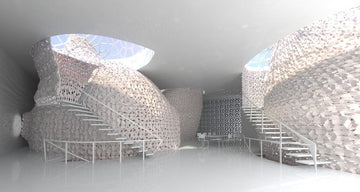Design Freedom and Customization:
a. Limitless Design Options: 3D printing liberates jewelry designers from the constraints of traditional manufacturing methods. Intricate and complex geometries that were once difficult to achieve are now easily accessible, pushing the boundaries of jewelry aesthetics.b. Personalization: Consumers can participate in the design process, customizing jewelry pieces to suit their preferences. Whether it's adding initials, names, or significant dates, each piece can carry a special meaning for the wearer.
c. Collaboration with Designers: Jewelry designers can collaborate with clients, offering bespoke services to create one-of-a-kind pieces that reflect the client's vision and personality.
Material Selection:
a. Precious Metals: 3D printing allows for the creation of jewelry in various precious metals, such as gold, silver, platinum, and more. The ability to print directly in metal opens up new design possibilities.b. Fashionable Materials: Beyond precious metals, 3D printing enables the use of fashionable materials like stainless steel, brass, bronze, and even porcelain or ceramics.
c. Advanced Materials: Cutting-edge materials, like titanium and aluminum, are also accessible through 3D printing, allowing for lightweight and durable jewelry designs.
Complex and Intricate Designs:
a. Filigree and Lace-Like Patterns: 3D printing makes it possible to create delicate and intricate filigree patterns that were once challenging to achieve with traditional methods.b. Organic and Nature-Inspired Designs: Embrace the beauty of nature by designing jewelry inspired by organic shapes, such as leaves, flowers, or seashells, made possible by the precision of 3D printing.
Minimal Waste and Sustainability:
a. Reduced Material Waste: Traditional jewelry manufacturing often generates significant material waste. With 3D printing, only the required material is used, reducing waste and environmental impact.b. Recycling and Repurposing: 3D printing allows for recycling and repurposing materials, contributing to sustainable and eco-friendly jewelry production.
Innovative Jewelry Techniques:
a. Parametric Design: Leverage parametric design principles to create dynamic and flexible jewelry pieces that can be personalized further based on user input.b. Kinetic and Interactive Jewelry: Integrate moving parts and interactive elements into jewelry designs, adding a touch of whimsy and playfulness.
Accessibility and Affordability:
a. Customization at All Budgets: 3D printing allows for custom jewelry creation at various price points, making personalized jewelry accessible to a broader audience.b. On-Demand Production: Jewelry designers can use 3D printing to produce pieces on demand, minimizing inventory costs and ensuring a sustainable business model.






